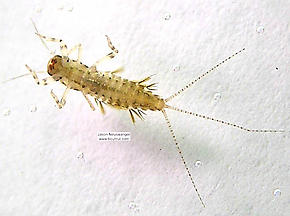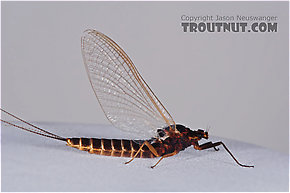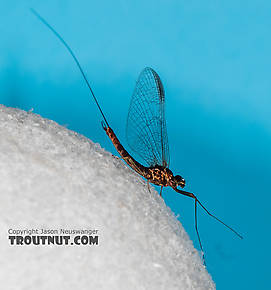Blog & Latest Updates
Fly Fishing Articles
Insects by Common Name


Black Quills
Scientific Names
| Match | Scientific Name |
| Leptophlebia | |
| Rhithrogena hageni | |
| Rhithrogena morrisoni |
Like most common names, "Black Quill" can refer to more than one taxon. They're previewed below, along with 9 specimens. For more detail click through to the scientific names.
Mayfly Genus Leptophlebia
These are often called Black Quills.
Leptophlebia mayflies do not generate superhatches, but their medium-large size and other properties make them a relevant part of the early season.
The information below was mostly discovered in Leptophlebia cupida, the most important species, but it is not known to differ in the others.
The information below was mostly discovered in Leptophlebia cupida, the most important species, but it is not known to differ in the others.
Female Leptophlebia (Black Quills and Blue Quills) Mayfly Dun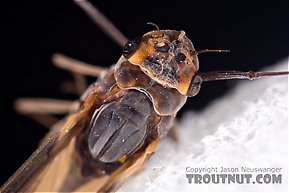 View 7 PicturesI collected this mayfly after user Al514 tipped me off to the presence of some Leptophlebia mayflies I didn't seem to have yet with his ID request of a male dun. This seems to be of the same species. I also collected a female spinner. Based on that spinner, I can tell that this is either Leptophlebia cupida or Leptophlebia nebulosa, but I can't tell which.
View 7 PicturesI collected this mayfly after user Al514 tipped me off to the presence of some Leptophlebia mayflies I didn't seem to have yet with his ID request of a male dun. This seems to be of the same species. I also collected a female spinner. Based on that spinner, I can tell that this is either Leptophlebia cupida or Leptophlebia nebulosa, but I can't tell which.
Unfortunately none of the specimens I collected made it through the hot, sunny day very well. So the pictures aren't great, but they're better than nothing.
 View 7 PicturesI collected this mayfly after user Al514 tipped me off to the presence of some Leptophlebia mayflies I didn't seem to have yet with his ID request of a male dun. This seems to be of the same species. I also collected a female spinner. Based on that spinner, I can tell that this is either Leptophlebia cupida or Leptophlebia nebulosa, but I can't tell which.
View 7 PicturesI collected this mayfly after user Al514 tipped me off to the presence of some Leptophlebia mayflies I didn't seem to have yet with his ID request of a male dun. This seems to be of the same species. I also collected a female spinner. Based on that spinner, I can tell that this is either Leptophlebia cupida or Leptophlebia nebulosa, but I can't tell which.Unfortunately none of the specimens I collected made it through the hot, sunny day very well. So the pictures aren't great, but they're better than nothing.
See 17 more specimens...
Mayfly Species Rhithrogena hageni
These are very rarely called Black Quills.
According to Fred Arbona in Mayflies, the Angler, and the Trout, this is an excellent hatch and one of the most common fast-water mayflies in the West.
Rhithrogena hageni (Western Black Quill) Mayfly Nymph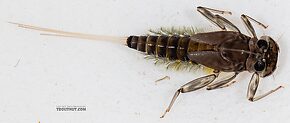 View 9 PicturesI'm basing the ID of this near-mature nymph on a male spinner with similar size and markings, collected on the same trip. There isn't a key to reliably identify the nymphs of most Rhithrogena species otherwise.
View 9 PicturesI'm basing the ID of this near-mature nymph on a male spinner with similar size and markings, collected on the same trip. There isn't a key to reliably identify the nymphs of most Rhithrogena species otherwise.
 View 9 PicturesI'm basing the ID of this near-mature nymph on a male spinner with similar size and markings, collected on the same trip. There isn't a key to reliably identify the nymphs of most Rhithrogena species otherwise.
View 9 PicturesI'm basing the ID of this near-mature nymph on a male spinner with similar size and markings, collected on the same trip. There isn't a key to reliably identify the nymphs of most Rhithrogena species otherwise.Female Rhithrogena hageni (Western Black Quill) Mayfly Dun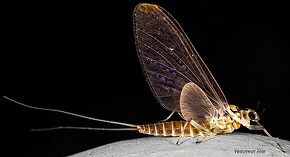 View 7 PicturesI was surprised by the olive cast on the body of this female Rhithrogena dun, which led me to mistake it for a western green drake (Drunella) in the field. I was pleasantly surprised to get a closer look and find something I hadn't collected yet. Its species ID is based on proximity to male spinner collected on the same trip, as well as physical similarity (size, tergite (
View 7 PicturesI was surprised by the olive cast on the body of this female Rhithrogena dun, which led me to mistake it for a western green drake (Drunella) in the field. I was pleasantly surprised to get a closer look and find something I hadn't collected yet. Its species ID is based on proximity to male spinner collected on the same trip, as well as physical similarity (size, tergite (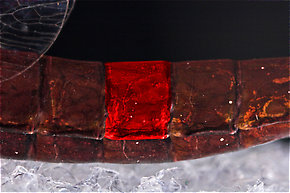 Tergite: The top (dorsal) part of a single segment on an insect's abdomen when it consists of a single chitinous plate (sclerite), or an individual sclerite if the segment has more than one.) coloration, dark streaks on the femora (
Tergite: The top (dorsal) part of a single segment on an insect's abdomen when it consists of a single chitinous plate (sclerite), or an individual sclerite if the segment has more than one.) coloration, dark streaks on the femora (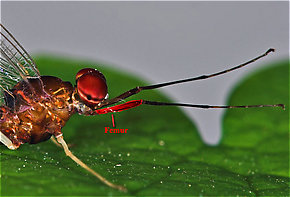 Femur: The main segment of an insect's leg close to the body, in between the tibia and the trochanter.)) to that specimen.
Femur: The main segment of an insect's leg close to the body, in between the tibia and the trochanter.)) to that specimen.
 View 7 PicturesI was surprised by the olive cast on the body of this female Rhithrogena dun, which led me to mistake it for a western green drake (Drunella) in the field. I was pleasantly surprised to get a closer look and find something I hadn't collected yet. Its species ID is based on proximity to male spinner collected on the same trip, as well as physical similarity (size, tergite (
View 7 PicturesI was surprised by the olive cast on the body of this female Rhithrogena dun, which led me to mistake it for a western green drake (Drunella) in the field. I was pleasantly surprised to get a closer look and find something I hadn't collected yet. Its species ID is based on proximity to male spinner collected on the same trip, as well as physical similarity (size, tergite (
One tergite of this Isonychia bicolor mayfly spinner is highlighted in red.

The femur of this Isonychia bicolor mayfly spinner is highlighted in red.
Male Rhithrogena hageni (Western Black Quill) Mayfly Spinner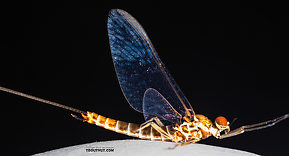 View 14 PicturesAlthough I could not find the preserved specimen to examine under my good new microscope, I'm tentatively calling it one Rhithrogena hageni, based on apparent similarity to this specimen, which I was able to positively ID.
View 14 PicturesAlthough I could not find the preserved specimen to examine under my good new microscope, I'm tentatively calling it one Rhithrogena hageni, based on apparent similarity to this specimen, which I was able to positively ID.
The relative angle of the penes (Penes: The paired genital structures of most male insects, which vary widely in form and are one of the main characteristics used for species identification.) is a bit shallower in this specimen, but I photographed another specimen from the same collecting trip (and I think even the same swarm, although I don't recall for sure) as the other one, and it had the shallower angle seen on this specimen. I'm guessing it's just variation within the species.
 View 14 PicturesAlthough I could not find the preserved specimen to examine under my good new microscope, I'm tentatively calling it one Rhithrogena hageni, based on apparent similarity to this specimen, which I was able to positively ID.
View 14 PicturesAlthough I could not find the preserved specimen to examine under my good new microscope, I'm tentatively calling it one Rhithrogena hageni, based on apparent similarity to this specimen, which I was able to positively ID. The relative angle of the penes (Penes: The paired genital structures of most male insects, which vary widely in form and are one of the main characteristics used for species identification.) is a bit shallower in this specimen, but I photographed another specimen from the same collecting trip (and I think even the same swarm, although I don't recall for sure) as the other one, and it had the shallower angle seen on this specimen. I'm guessing it's just variation within the species.
See 1 more specimens...
Mayfly Species Rhithrogena morrisoni
These are very rarely called Black Quills.
Despite the reputation of Rhithrogena as being the most tenacious of clingers, Rhithrogena morrisoni or Western March Brown has the greatest populations in moderate runs over cobble. It can reach amazing densities in this water type on rivers like the Rogue in Oregon, Lower Yuba In California, and the Henry's Fork in Idaho.
These large flies range between 9mm and 12mm and are the first important hatch of the year. Generally speaking, they have two distinct color phases and hatching periods, with the Coastal states having the lighter version emerging late February through April in lower elevation tailwaters and the darker version in the Rocky mountain states emerging a month or two later. This has led to much confusion as these significant regional differences are seldom pointed out in angling literature.
They offer the western angler some of the finest fishing of the year during moderate precipitation cycles. It's biggest spoiler is high water or early runoff. On many rivers, there is also a fine hatch of a large late Winter stonefly (Skwala spc.) that usually precedes it that helps to get the fish "looking up". It is the West's equivalent of the East's mottle winged Macaffertium vicarium (American March Brown), both in terms of appearance and importance. Primarily due to western fishing seasons of the past that excluded this mayfly's activity, reporting on this species in angling literature is a relatively recent phenomenon. Thus, it lags in tradition compared to the blotchy winged Heptageniidae of the East and Midwest. But given time...
These large flies range between 9mm and 12mm and are the first important hatch of the year. Generally speaking, they have two distinct color phases and hatching periods, with the Coastal states having the lighter version emerging late February through April in lower elevation tailwaters and the darker version in the Rocky mountain states emerging a month or two later. This has led to much confusion as these significant regional differences are seldom pointed out in angling literature.
They offer the western angler some of the finest fishing of the year during moderate precipitation cycles. It's biggest spoiler is high water or early runoff. On many rivers, there is also a fine hatch of a large late Winter stonefly (Skwala spc.) that usually precedes it that helps to get the fish "looking up". It is the West's equivalent of the East's mottle winged Macaffertium vicarium (American March Brown), both in terms of appearance and importance. Primarily due to western fishing seasons of the past that excluded this mayfly's activity, reporting on this species in angling literature is a relatively recent phenomenon. Thus, it lags in tradition compared to the blotchy winged Heptageniidae of the East and Midwest. But given time...
Rhithrogena morrisoni (Western March Brown) Mayfly Nymph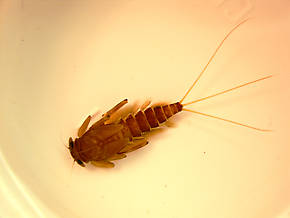 View 4 PicturesSize - (excluding tails) - 12 mm
View 4 PicturesSize - (excluding tails) - 12 mm
Status at time of photo - preserved, but photographed within days of capture.
W. C. Day, Aquatic Insects of California differentiates morrisoni nymphs by submedian pale dots on tergites ( Tergite: The top (dorsal) part of a single segment on an insect's abdomen when it consists of a single chitinous plate (sclerite), or an individual sclerite if the segment has more than one.) 8 & 9, which look to be in evidence. This is one of the "super-hatches" on this river that can be prolific March through April.
Tergite: The top (dorsal) part of a single segment on an insect's abdomen when it consists of a single chitinous plate (sclerite), or an individual sclerite if the segment has more than one.) 8 & 9, which look to be in evidence. This is one of the "super-hatches" on this river that can be prolific March through April.
Entoman
 View 4 PicturesSize - (excluding tails) - 12 mm
View 4 PicturesSize - (excluding tails) - 12 mmStatus at time of photo - preserved, but photographed within days of capture.
W. C. Day, Aquatic Insects of California differentiates morrisoni nymphs by submedian pale dots on tergites (

One tergite of this Isonychia bicolor mayfly spinner is highlighted in red.
Entoman
See 1 more specimens...
Top 10 Fly Hatches
Top Gift Shop Designs
Eat mayflies.
Top Insect Specimens
Miscellaneous Sites
Troutnut.com is copyright © 2004-2024 Jason
Neuswanger (email Jason). See my FAQ for information about use of my images.
 privacy policy
privacy policy

